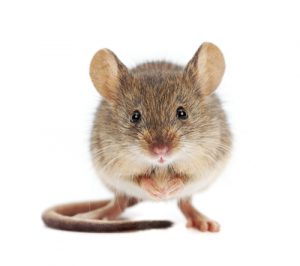Could This Be a Mouse Nest?
By Chris Williams on June 9, 2011.
Q. Behind my stove, I found this wad of string and fuzz and pieces of paper. And it smells funny. Is this what a mouse nest looks like? If so, Eeek!
A. Well, it does fit all the criteria for a mouse nest: design, material, and location, location, location! Indoors, mice typically nest in hidden areas inside walls and voids (including ceiling voids), under stoves and refrigerators, inside equipment, in boxes, behind kickplates, in clutter and debris, inside furniture and drawers and in wire chases. Nests are built in a warm place close to water and food. Mice rarely travel more than 30 feet from their nest to a food source, so for a mouse, a nest in a warm kitchen is perfect.
The pregnant female mouse will shred paper, cloth, plastic, burlap, string, insulation, leaves, plants, any soft material she can find to make a nest. In fact, if you are trapping mice, baiting the trap with nesting material like a cotton ball or string is often very effective where there are pregnant females. When there is plenty of nesting material available, the female will make as many as 150 foraging trips in a single night to collect nest material. She assembles her collection into a loose, fibrous ball about 4 inches across. Mouse nests often contain bits and pieces of hoarded food as well.
 A typical female house mouse will produce 42-60 offspring in a year (5 to 7 young in a litter), but variations in genetics, food supply, competition, predation, and temperature can affect the number of births and the survival of offspring. But in a home, where there is usually plenty of food and little or no predation (unless you have a cat!), mice survive and reproduce very well. Some can live for two years or more in these ideal conditions.
A typical female house mouse will produce 42-60 offspring in a year (5 to 7 young in a litter), but variations in genetics, food supply, competition, predation, and temperature can affect the number of births and the survival of offspring. But in a home, where there is usually plenty of food and little or no predation (unless you have a cat!), mice survive and reproduce very well. Some can live for two years or more in these ideal conditions.
As the mouse population grows, crowded mice simply move to less crowded areas like nearby rooms and start new families. Each mouse family occupies its own territory usually made up of a dominant male, several breeding females, some of their offspring and a few secondary males. When mice are left to their own devices, it doesn’t take long for a population to get out of control. In one experiment, 24 mice supplied with abundant food, water, and nesting sites, multiplied to 2,000 mice after only 8 months!
If you don’t want to share your home with mice, give Colonial a call. We’ll do a thorough inspection and can come up with a mouse control plan that works best for you. We’re also experts at mouse-proofing homes. Let us seal up all those small openings that mice use to get inside so you don’t have to worry about mice again.